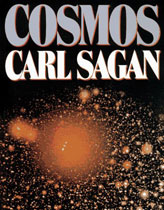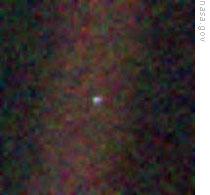VOA慢速英语 2008 1210b(在线收听)
This is Shirley Griffith.
VOICE TWO:
 |
| Carl Sagan |
And this is Steve Ember with the VOA Special English program Explorations. Today we tell about American scientist Carl Sagan. He spent much of his life helping make space travel possible far out in the universe. He also helped people understand science.
(MUSIC)
VOICE ONE:
The year is nineteen forty-seven. Twelve-year-old Carl Sagan is standing outside a small house in the eastern city of Brooklyn, New York. It is dark. He is looking up at the sky. After a few minutes, he finds the spot for which he has been searching. It is a light red color in the night sky. Carl is looking at the planet Mars.
Carl has just finished reading a book by American writer Edgar Rice Burroughs. It is the story of a man who travels from Earth to the planet Mars. He meets many strange and interesting creatures there. Some of them are very human. The name of the book is “The Princess of Mars.” It is just one of many books that Mister Burroughs wrote about travels to Mars.
VOICE TWO:
In “The Princess of Mars,” the man who travels to Mars can make the trip by looking at the planet for several minutes. He then is transported there by a strange force.
Carl Sagan stands watching the red planet. He wishes he could travel across the dark, cold distance of space to the planet Mars. After a while, young Carl realizes this will not happen. He turns to enter his home. But in his mind he says, "Some day. . . Some day it will be possible to travel to Mars. "
VOICE ONE:
Carl Sagan never had the chance to go to Mars. He died in December, nineteen ninety-six. However, much of the work he did during his life helped make it possible for the American Pathfinder vehicle to land on Mars. It landed on July fourth, nineteen ninety-seven. It soon began sending back to Earth lots of information and thousands of pictures about the red planet.
Carl Sagan's friends and family say he would have been extremely happy about the new information from Mars. They say he would have told as many people as possible about what Pathfinder helped us learn.
VOICE TWO:
Carl Sagan was a scientist. He was also a great teacher. He helped explain extremely difficult scientific ideas to millions of people in a way that made it easy to understand. He made difficult science sound like fun.
(MUSIC)
VOICE ONE:
Carl Sagan was born in Brooklyn, New York in nineteen thirty-four. Even as a child he wanted to be a scientist. He said it was a child's science book about stars that helped him decide to be a scientist.
Mister Sagan said he read a book that told how our sun is a star that is very close to Earth. The book also said that the stars in the night sky were also suns but very far away. Mister Sagan said that suddenly, this simple idea made the universe become much larger than just Brooklyn, New York.
VOICE TWO:
It should be no surprise to learn that Carl Sagan studied the stars and planets when he grew older. He did this at the University of Chicago. Later he taught astronomy at Harvard University and Cornell University.
In the nineteen fifties, Mister Sagan helped design mechanical devices for use on some of the first space flights.
He also published two important scientific theories that were later confirmed by space flights. One theory was that Venus is extremely hot. The other was that Mars did not have a season when plants grew as scientists had believed. He said that the dark areas on Mars that were thought to be plants were really giant dust storms in the Martian atmosphere.
VOICE ONE:
 |
| Carl Sagan with a model of NASA's Viking spacecraft |
Mister Sagan was deeply involved in American efforts to explore the planets in our solar system. He was a member of the team that worked on the voyage of Mariner Nine to Mars. It was launched in nineteen seventy-one. Mariner Nine was the first space vehicle to orbit another planet.
Mister Sagan helped choose the landing area for Viking One and Viking Two, the first space vehicles to successfully land on Mars. He also worked on Pioneer Two, the first space vehicle to investigate the planet Jupiter. And he worked on Pioneer Eleven, which flew past Jupiter and Saturn.
VOICE TWO:
Carl Sagan was a member of the scientific team that sent the Voyager One and Voyager Two space vehicles out of our solar system. He proposed the idea to put a message on the Voyager, on the chance that other beings will find the space vehicles in the distant future.
Mister Sagan worked for many months on what to say in the message. It was an extremely difficult task. When the Voyager space vehicles left our solar system they carried messages that included greetings from people in many languages. They carried the sound of huge whales in our oceans. And they carried the sound of ninety minutes of many different kinds of music from people around the world. Carl Sagan had created a greeting from the planet Earth.
(MUSIC)
VOICE ONE:
Carl Sagan was an extremely successful scientist and university professor. He was also a successful writer. He wrote more than six hundred scientific and popular papers during his life. And he wrote more than twelve books. In nineteen seventy-eight, he won the Pulitzer Prize for one of them. It is called “The Dragons of Eden: Speculations on the Evolution of Human Intelligence.” He even helped write a work of science fiction in the nineteen eighties. The book is called “Contact.” It is about the first meeting between beings from another world and the people of Earth. It was made into a popular movie.
VOICE TWO: Perhaps Carl Sagan may best be remembered for his many appearances on television. He used television very effectively in his efforts to make science popular. He first became famous in nineteen eighty when he appeared on a thirteen-part television series about science. The show was called “Cosmos." It explored many scientific subjects -- from the atom to the universe. It was seen by four hundred million people in sixty countries. Mister Sagan wrote a popular book based on his television show.
Perhaps Carl Sagan may best be remembered for his many appearances on television. He used television very effectively in his efforts to make science popular. He first became famous in nineteen eighty when he appeared on a thirteen-part television series about science. The show was called “Cosmos." It explored many scientific subjects -- from the atom to the universe. It was seen by four hundred million people in sixty countries. Mister Sagan wrote a popular book based on his television show.
VOICE ONE:
Millions of people saw Carl Sagan on television in the nineteen seventies and nineteen eighties. He especially liked to talk about science and scientific discoveries on the late night television program "The Tonight Show with Johnny Carson." Mister Sagan said he always tried to accept invitations to “The Tonight Show” because about ten million people watched it, people who were not usually interested in science.
On television, Mister Sagan was a good storyteller. He was able to explain complex scientific ideas in simple ways. He believed that increasing public excitement about science is a good way to get more public supporters. He said much of the money for science and scientific studies comes from the public, and people should know how their money is being spent.
VOICE TWO:
Some scientists criticized Carl Sagan because of his many appearances on television. They said he was not being serious enough about science. They said he was spending too much time appearing on television trying to make science popular.
Other scientists valued his efforts to explain science. They said he communicated his message with joy and meaning.
VOICE ONE:
One of Carl Sagan's last books is called “The Pale Blue Dot: A Vision of the Human in Space.” Mister Sagan said he got the idea for the book from a picture taken by the Voyager One space vehicle. As it passed the planet Neptune, Voyager turned its cameras back toward the distant Earth and took a picture of the Earth as a pale blue dot. Mister Sagan described the Earth this way:
 |
| Earth as a very small dot in an image taken by the Voyager One spacecraft at the edge of the solar system |
CARL SAGAN: "Consider again that dot. That's here. That's home. That's us. On it everyone you love, everyone you know, everyone you ever heard of, every human being who ever was, lived out their lives. The aggregate of our joy and suffering, thousands of confident religions, ideologies, and economic doctrines, every hunter and forager, every hero and coward, every creator and destroyer of civilization, every king and peasant, every young couple in love, every mother and father, hopeful child, inventor and explorer, every teacher of morals, every corrupt politician, every "superstar," every "supreme leader," every saint and sinner in the history of our species lived there -- on a mote of dust suspended in a sunbeam...
It has been said that astronomy is a humbling and character-building experience. There is perhaps no better demonstration of the folly of human conceits than this distant image of our tiny world. To me, it underscores our responsibility to deal more kindly with one another, and to preserve and cherish the pale blue dot, the only home we've ever known."
VOICE TWO:
Carl Sagan died December twentieth, nineteen ninety-six in Seattle, Washington. He was being treated at a medical center there for a bone marrow disease. Carl Sagan was sixty-two years old.
(MUSIC)
VOICE ONE:
This Special English program was written by Paul Thompson and Nancy Steinbach. It was produced by Paul Thompson and Mario Ritter.
This is Shirley Griffith.
VOICE TWO:
And this is Steve Ember. You can learn more about Carl Sagan on our Web site, voaspecialenglish.com.
Join us again next week for Explorations in VOA Special English.